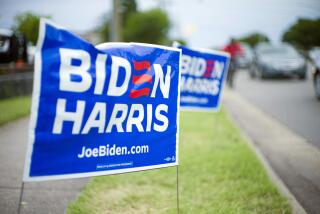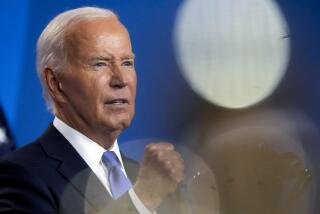Early Tests Show Democrats Face Hard Struggle
WASHINGTON — The ballots cast Tuesday in the Democrats’ most important round of contests to date made it eminently clear that a hard struggle lies ahead before the party finds its 1992 standard-bearer.
And that spells the end of Democratic leaders’ dream--perhaps never realistic--that the party could avoid the divisiveness of past campaigns, settle on a strong candidate early and concentrate on exploiting the unexpected vulnerabilities of the incumbent President.
“We’re in for a long argument,” said John Sasso, who managed Michael S. Dukakis’ 1988 presidential campaign.
Some Democrats, including Sasso, contend that a long campaign--fractious as it is beginning to be--ultimately could force the party to redefine itself in a way that would help bring back the voters who deserted it since the party last won the White House nearly two decades ago.
“It’s a healthy debate because it’s about the economy,” Sasso said. “I don’t see anything here that isn’t going to help the party.”
Because the two top contenders, Arkansas Gov. Bill Clinton and former Massachusetts Sen. Paul E. Tsongas, offer sharply divergent messages, so this argument goes, they could broaden the party’s appeal. And if one of them eventually wins and reaches out to supporters of the other, the result could be a reforging of the electoral coalition that led to the New Deal, the New Frontier and the Great Society.
Clinton reaches out to blue-collar workers, the lower middle class and blacks, in the cities and countryside, while Tsongas appeals to the better-educated, white-collar and professional voters, and to suburbanites in general. The other Democratic contenders, in their different ways, make similarly divergent appeals.
But Tuesday’s results suggest that increasingly bitter battles are likely to occur before the nominee is selected. And if the Democrats’ past record is any indication, such strife is as likely to divide them further as it is to bring about reconciliation.
Tsongas and Clinton each won just enough Tuesday to help his own candidacy forge ahead, but neither came close to making himself dominant.
In addition, the surprising returns from Colorado and Utah vaulted former California Gov. Edmund G. (Jerry) Brown Jr. into a more prominent role and positioned him to make it even more difficult for either of the front-runners to achieve a majority. Brown won a close contest in Colorado--with 96% of the vote in, he had 30% to Clinton’s 28% and Tsongas’ 26%. In Utah, Brown finished a solid second behind Tsongas.
Analysts believe that with the race dominated by the two relatively conservative contenders, Brown can keep his candidacy alive from week to week by appealing to the frustrated members of what was once the party’s dominant liberal cadre.
In a sense Brown--with his emotional anti-Establishment populist message--would fill the role for liberals that the Rev. Jesse Jackson played in the 1984 and 1988 campaigns.
Clinton’s big victory in Georgia reaffirmed his claim to his base in Dixie just a week before the multistate Super Tuesday contests involving 11 states, many of them in or bordering the South.
“I think Clinton had a tremendous victory here (in Georgia),” said Merle Black, Emory University specialist in Southern politics. “I think he really set himself up for the South Carolina primary (this Saturday) and for Super Tuesday.”
As for Tsongas, his success in Maryland established him as a national candidate and assured him of the funding he needs to carry on the fight.
Mark Siegel, a Democratic political strategist whose experience dates back to the presidential campaigns of Hubert H. Humphrey in the ‘60s, thinks that Tsongas’ appeal to higher-income and better-educated voters should help him win delegates in the relatively affluent suburbs outside Chicago and in suburban areas of Michigan beyond Detroit when Illinois and Michigan vote on March 17.
Of course, Clinton’s partisans were quick to point out that their man also had demonstrated breadth of appeal by his strong showing in the Colorado primary, and now they looked ahead to the next two weeks of contests.
“March 10 will be when Bill Clinton breaks out of the pack,” said Mickey Kantor, chairman of the Clinton campaign’s national executive committee. The Illinois and Michigan contests will give Clinton the chance to show that he can win in a Northern industrial state. After that, Kantor said, “the inevitability factor will begin to set in,” when the campaign’s anticipated successes will feed on each other, aided and abetted by Clinton’s considerable financial advantage.
“Winning takes care of a lot of people’s concerns,” said Kantor. “This is a delegate race. . . . What the other campaigns don’t have the resources for and never understood is that’s the imperative of this race. You must be everywhere” to win delegates, and the others can’t afford to do that.
“Mondale went through a terrible period in 1984, but he kept piling up delegates, and he was still the nominee. No one hands you this. You have to fight for it.”
The returns in Georgia meant that the Tsongas forces probably faced slim pickings in most of the South. But his strategists were aiming at selected upper-income suburban areas in Texas and Florida where they were convinced they could win delegates much as Dukakis did in the 1988 Super Tuesday contests.
Some thought Florida, with its large population of emigres from the North, would be a particularly good target. “Don’t forget the winner of the New Hampshire primary gets a big boost in Florida,” said Sasso, recalling that in 1984 Gary Hart won Florida after winning in New Hampshire--a pattern repeated by Dukakis in 1988.
Tsongas’ win in Utah bolstered his claim that he is a candidate with nationwide appeal.
Apart from his populist message, Brown has other assets that can help to fuel his campaign. As the former two-term governor of the nation’s largest state and as the only one of the present contenders to have run for President before--in 1976 and 1980--Brown has considerable name recognition, particularly in the West. These factors helped swell his vote totals in both Colorado and Utah Tuesday.
And because he has tailored his low-overhead operation on his self-imposed $100 ceiling on campaign contributions, Brown operates on a far more Spartan basis than his rivals.
Along with the advantage of minimum expenses goes the blessing of minimum expectations. Because of his unorthodox approach, most politicians have not considered him a serious possibility to win the nomination. So any success he achieves comes as a surprise, and has that much more impact.
The only sense in which Tuesday’s returns seemed to simplify the race was by making it appear that Nebraska Sen. Bob Kerrey and Iowa Sen. Tom Harkin were edging closer to elimination.
Harkin won in the Minnesota caucuses, as had been expected, and eked out a victory in Idaho as well. But his strategist had said beforehand that he needed to run strong enough in Minnesota and the caucuses in Washington and Idaho to win more delegates for the day than any other candidates--a development that seemed unlikely.
Kerrey, meanwhile, was unable to capitalize on his South Dakota success last week; he finished out of the money everywhere.
Times staff writer David Lauter also contributed to this story.
More to Read
Get the L.A. Times Politics newsletter
Deeply reported insights into legislation, politics and policy from Sacramento, Washington and beyond. In your inbox three times per week.
You may occasionally receive promotional content from the Los Angeles Times.










